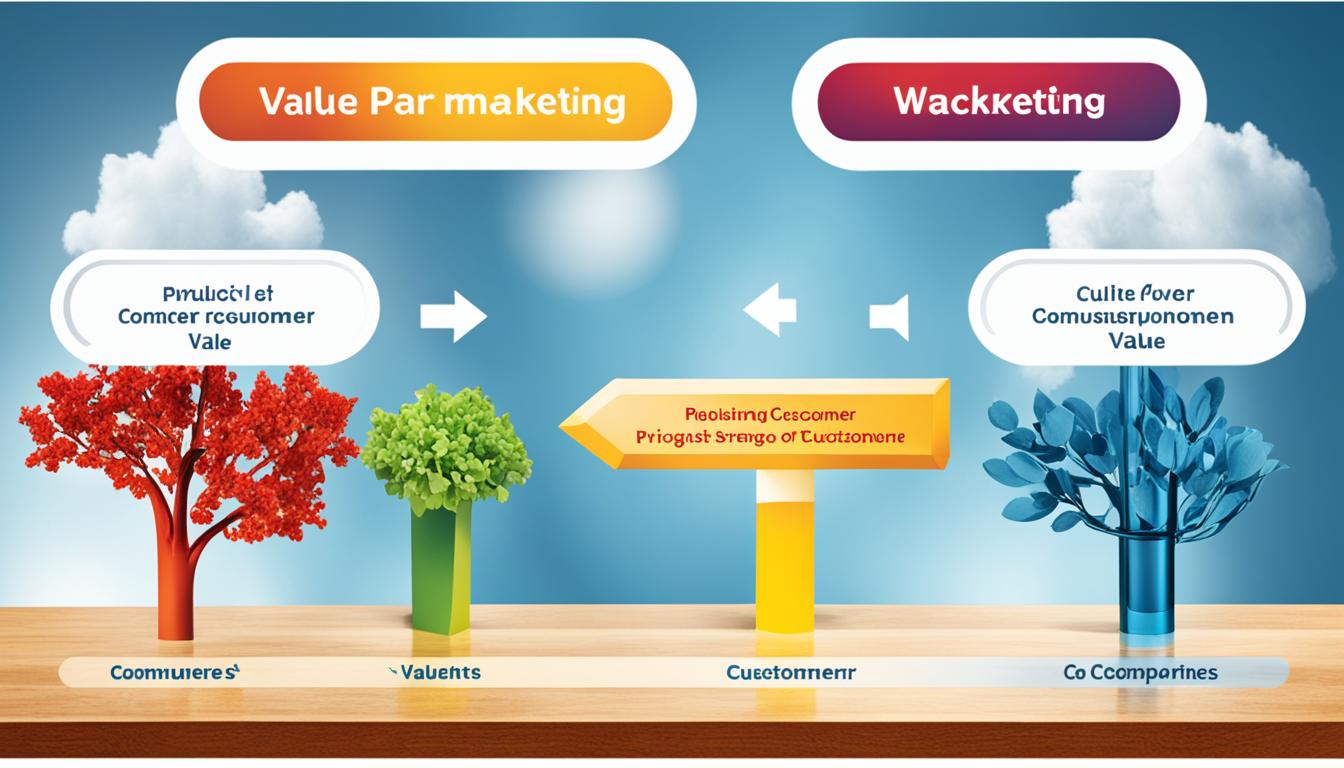Real-time bidding (RTB) is a crucial component of programmatic advertising that enables the buying and selling of digital ads in real time. It operates by conducting online advertising auctions, where multiple advertisers compete to display their ads to users on a per-impression basis. This automated process occurs in milliseconds, allowing advertisers to target specific audiences and adjust their campaign budgets in real time.
Key Takeaways:
- Real-time bidding (RTB) is a subcategory of programmatic advertising that facilitates the buying and selling of ads in real time on a per-impression basis.
- RTB is facilitated by ad exchanges or supply-side platforms (SSPs) and involves multiple advertisers bidding for the same impression.
- RTB offers fine-tuned targeting, better return on investment (ROI), and the ability to adjust campaign budgets in real time.
- Advertisers use demand-side platforms (DSPs) to set up and track their campaigns, while publishers use SSPs to list their ad inventory.
- Real-time bidding increases revenue and fill rates for publishers and provides more efficient and targeted buying for advertisers.
How Does Real-Time Bidding Work?
Real-time bidding (RTB) is a fundamental component of programmatic advertising that enables the buying and selling of ads in real-time on a per-impression basis. To understand how RTB works, let’s delve into the complex process involving advertisers, publishers, supply-side platforms (SSPs), demand-side platforms (DSPs), ad exchanges, and impressions.
Advertisers and Publishers
Advertisers utilize demand-side platforms (DSPs) to set up and track their advertising campaigns. DSPs provide advertisers with the tools and capabilities to apply targeting parameters, evaluate ad potential in real time, and place bids on ad impressions. On the other hand, publishers use supply-side platforms (SSPs) to list their ad inventory, thereby giving advertisers access to a wide range of potential impressions.
Ad Exchanges and Real-Time Bidding Auctions
Ad exchanges act as the central marketplace that connects advertisers and publishers. They facilitate the real-time bidding auction process where multiple advertisers compete for a single ad impression. Advertisers analyze the value of the impression and place their bid accordingly, considering factors such as targeting parameters, campaign budgets, and ad relevance. The auction takes place instantaneously, with the highest bid winning the impression.
Impressions and Payment
Impressions play a crucial role in real-time bidding. As an ad is served to a user, it is counted as an impression. Advertisers pay for the impressions their ads receive based on the winning bid. This payment model ensures that advertisers only incur costs when their ads are actually shown to users, making real-time bidding a cost-effective approach.
By understanding the intricate process of real-time bidding, advertisers and publishers can leverage this transformative technology to optimize their advertising campaigns, target relevant audiences, and maximize their return on investment.
Benefits for Advertisers
Real-time bidding (RTB) offers several key benefits for advertisers in the realm of programmatic advertising. By leveraging the power of RTB, advertisers can take advantage of targeted buying, resulting in improved return on investment (ROI) and the delivery of more relevant ads to their target audience.
One of the main advantages of real-time bidding is the ability to streamline and optimize the buying process. Advertisers can apply fine-tuned targeting parameters to their campaigns, ensuring that their ads are shown to the most relevant audience. This targeted approach increases the likelihood of user engagement and conversion rates.
With real-time bidding, advertisers can also make real-time adjustments to their campaign budgets. This flexibility allows for the optimization of ad performance based on real-time data and insights. Advertisers can monitor the effectiveness of their campaigns and make necessary adjustments to maximize their ROI.
By utilizing real-time bidding, advertisers can ensure that their ads are highly relevant to users. The ability to target specific audiences based on a range of factors, such as demographics, interests, and browsing behavior, enables advertisers to deliver personalized and impactful ads that resonate with their target market.
Overall, real-time bidding enables advertisers to make more informed buying decisions, increase their ROIs, and deliver more relevant advertisements to their target audience.
Benefits for Advertisers: Summary
| Benefits of Real-Time Bidding for Advertisers |
|---|
| Targeted buying |
| Improved ROI |
| Delivery of relevant ads |
| Real-time adjustments to campaign budgets |
Benefits for Publishers
Real-time bidding (RTB) in programmatic advertising offers significant benefits for publishers, enhancing their revenue and fill rates while providing a competitive advantage in the market. By participating in real-time auctions, publishers open up their ad inventory to a wider range of buyers, increasing the chances of selling impressions at higher prices.
One of the primary benefits of RTB for publishers is the increased revenue it generates. The competitive nature of the auction helps drive up the prices for ad placements, resulting in higher earnings for publishers. They can leverage the programmatic advertising ecosystem to maximize the value of their inventory and optimize revenue streams.
Moreover, real-time bidding ensures higher fill rates for publishers. By allowing multiple advertisers to bid on ad impressions in real time, the chances of fill rates are significantly increased. This means that publishers can monetize their ad inventory with a higher likelihood of serving an ad to the user, reducing the number of unsold impressions.
The competitive auction environment in real-time bidding contributes to the visibility publishers gain into who is purchasing their inventory. This information empowers publishers to make informed decisions about their pricing strategies and charge more for premium ad placements. Publishers can identify and cater to high-value buyers, leading to better monetization opportunities.
Overall, real-time bidding enables publishers to optimize their advertising inventory, drive revenue growth, and maximize their exposure in the programmatic advertising landscape.
Benefits for Publishers in Real-Time Bidding
| Benefits | Description |
|---|---|
| Increased Revenue | Real-time bidding drives up ad prices, resulting in higher earnings for publishers. |
| Higher Fill Rates | Real-time bidding increases the likelihood of selling ad impressions, reducing the number of unsold inventory. |
| Competitive Auction | The auction environment in real-time bidding allows publishers to charge more for premium ad placements. |
| Visibility | Publishers gain insight into the buyers of their inventory, enabling informed pricing decisions. |
Real-Time Bidding Platforms
Real-time bidding (RTB) relies on a variety of platforms that enable the seamless flow of programmatic advertising and ad auctions. Demand-side platforms (DSPs) and supply-side platforms (SSPs) play a crucial role in facilitating real-time bidding and connecting advertisers and publishers in the ad exchange ecosystem.
For advertisers, DSPs offer a comprehensive suite of tools and features to manage and optimize their real-time bidding campaigns. These platforms allow advertisers to set targeting parameters, place bids on impressions, and track campaign performance in real time. Some popular DSPs include:
- AdRoll
- mediasmart
- theTradeDesk
On the other side of the equation, publishers rely on SSPs to list their ad inventory and maximize their revenue through real-time bidding. SSPs provide publishers with the necessary infrastructure to monetize their digital assets and effectively participate in ad exchanges. Some widely used SSPs include:
- Magnite
- Index Exchange
These platforms act as intermediaries, ensuring that the bidding process between advertisers and publishers occurs smoothly and efficiently. Ad exchanges bring together DSPs and SSPs to create a thriving marketplace for real-time bidding, allowing for the transaction of impressions in real time.
To further illustrate the real-time bidding ecosystem, we’ve created a table detailing the key features and benefits of DSPs and SSPs:
| Platform | Key Features | Benefits |
|---|---|---|
| Demand-Side Platform (DSP) | Targeting parameters, real-time bidding, campaign tracking | Optimized ad campaigns, precise audience targeting, campaign flexibility |
| Supply-Side Platform (SSP) | Ad inventory management, monetization, publisher insights | Increased revenue, higher fill rates, visibility into ad performance |
By leveraging these real-time bidding platforms, advertisers and publishers can harness the power of programmatic advertising to achieve their marketing goals effectively and efficiently.
How Real-Time Bidding Fits into Programmatic Advertising
Real-time bidding (RTB) is a subcategory of programmatic advertising, an automated process for buying and selling online ads. RTB enables the automatic purchase of ad inventory and the placement of ads online, optimizing the ad delivery process. Advertisers participate in real-time auctions to bid on ad space, aiming to reach their target audience effectively. This automated approach streamlines the ad buying process, making it more efficient and cost-effective.
Programmatic advertising, in general, utilizes technology to automate different aspects of the ad buying journey. It involves the use of algorithms and data analysis to determine the best ad placements, target the right audience, and optimize campaigns in real-time. Real-time bidding complements programmatic advertising by allowing advertisers to bid on individual ad impressions in real-time auctions.
The real-time bidding process operates on a cost per mille (CPM) model, where advertisers pay for the number of impressions their ads receive. Advertisers can set specific targeting parameters to ensure their ads reach the most relevant audience. By participating in real-time auctions, they gain access to ad inventory across multiple publishers and platforms, enhancing the visibility and reach of their campaigns.
Through real-time bidding, advertisers have greater control over their ad spend, as they can make data-driven decisions based on the performance of their ads in real-time. Additionally, the automated nature of real-time bidding simplifies the ad buying process, saving advertisers time and resources compared to traditional manual buying methods.
In summary, real-time bidding is a crucial component of programmatic advertising. It enables the automated buying of ad inventory and placements, optimizing the ad delivery process. Advertisers participate in real-time auctions to bid on individual ad impressions, targeting their desired audience effectively. By utilizing real-time bidding, advertisers gain more control over their ad spend and benefit from the streamlined and efficient ad buying process.
Pros of Real-Time Bidding
Real-time bidding (RTB) in programmatic advertising offers several advantages that can greatly benefit advertisers. Let’s explore some of the key pros of real-time bidding:
Better Tracking Capabilities
Real-time bidding provides advertisers with better tracking capabilities compared to traditional advertising methods. Through RTB platforms, advertisers can access robust analytics and insights, allowing them to monitor the performance of their ads in real time. This data-driven approach empowers advertisers to make informed decisions and optimize their campaigns for optimal results.
More Accurate Targeting Based on Individual Profiles
One of the significant advantages of real-time bidding is the ability to target ads based on individual profiles. By leveraging data collected from various sources, including browsing behavior, demographic information, and past interactions, advertisers can deliver highly personalized and relevant ads to their target audience. This precise targeting helps increase engagement, conversion rates, and overall campaign effectiveness.
Cost-Effective Spending on High-Value Impressions
Real-time bidding allows advertisers to optimize their ad budgets by prioritizing high-value impressions. Through real-time auctions, advertisers can bid on ad inventory that aligns with their target audience, ensuring that their ads are displayed in the most relevant and effective contexts. By targeting high-value impressions, advertisers can maximize the impact of their campaigns and achieve a better return on investment (ROI).
Eliminates Manual Work Associated with Traditional Advertising
Real-time bidding eliminates the need for manual work involved in traditional advertising processes. With programmatic platforms and automated bidding, advertisers can streamline their advertising workflow and reduce time-consuming tasks. This increased efficiency allows advertisers to focus on crafting compelling ad creatives and refining their strategies, ultimately leading to better campaign outcomes.
Overall, real-time bidding offers advertisers better tracking capabilities, more accurate targeting, cost-effective spending, and eliminates the manual work associated with traditional advertising. By leveraging the power of RTB, advertisers can optimize their campaigns, reach the right audience at the right time, and achieve their marketing objectives more effectively.

| Advantages of Real-Time Bidding | Description |
|---|---|
| Better Tracking Capabilities | Real-time bidding provides advertisers with robust analytics and insights, enabling them to monitor ad performance in real time. |
| More Accurate Targeting Based on Individual Profiles | Real-time bidding allows advertisers to deliver personalized and relevant ads by leveraging data from various sources. |
| Cost-Effective Spending on High-Value Impressions | Real-time bidding enables advertisers to prioritize high-value impressions, maximizing the impact of their campaigns. |
| Eliminates Manual Work Associated with Traditional Advertising | Real-time bidding streamlines the advertising workflow, reducing manual tasks and freeing up time for strategic optimizations. |
Cons of Real-Time Bidding
While real-time bidding (RTB) and programmatic advertising offer many advantages, there are also certain drawbacks that advertisers need to be aware of. One significant concern is the potential for compromised brand safety.
Ads displayed through real-time bidding can sometimes be placed near inappropriate or offensive content, which can have a negative impact on a brand’s reputation and perception. Advertisers must carefully consider the context in which their ads are displayed to ensure they align with their brand values and maintain a safe and suitable environment for their ads.
Brand safety compromises in real-time bidding can occur due to the vast amount of ad inventory available and the automated nature of the bidding process. While ad exchanges and supply-side platforms (SSPs) strive to implement measures to prevent such incidents, it’s essential for advertisers to closely monitor their campaigns and make adjustments as necessary to uphold brand safety standards.
By establishing strict content guidelines, implementing brand safety tools, and constantly monitoring ad placements, advertisers can mitigate the risk of compromising their brand’s safety and protect their reputation. Additionally, partnering with trusted publishers and leveraging third-party verification services can provide an added layer of assurance for maintaining brand safety in real-time bidding.
Brand Safety Considerations in Real-Time Bidding
| Brand Safety Issue | Impact | Preventive Measures |
|---|---|---|
| Inappropriate or offensive content adjacency | Negative impact on brand perception and reputation | – Establish strict content guidelines – Implement keyword blocking – Utilize AI-powered brand safety tools |
| Fraudulent or non-human traffic | Waste of advertising budget and inaccurate campaign performance | – Use pre-bid fraud detection measures – Validate traffic quality through third-party verification services |
| Lack of transparency in ad placements | Difficulty in assessing ad context and suitability | – Partner with reputable publishers – Request transparency on ad placements – Leverage brand safety reports and analytics |
By taking proactive steps to address brand safety concerns, advertisers can maximize the benefits of real-time bidding while minimizing the risks associated with compromised brand safety.
Overview of Real-Time Bidding
Real-time bidding (RTB) is a form of programmatic advertising that enables the buying and selling of digital ads in real time. This process involves advertisers, publishers, supply-side platforms (SSPs), demand-side platforms (DSPs), and ad exchanges, all working together to facilitate effective ad placements.
Key Points:
- RTB allows for the real-time auction of ad impressions.
- Advertisers can bid on impressions based on their targeting preferences and budget.
- The highest bidder’s ad is displayed to the user when the impression becomes available.
- Advertisers benefit from precise targeting and improved return on investment (ROI).
- Publishers can maximize revenue by opening up their inventory to various advertisers.
- Ad exchanges connect advertisers and publishers, enabling the RTB auction.
To better understand how real-time bidding works, consider the following diagram:

The diagram illustrates the flow of the real-time bidding process, showing how technology platforms and stakeholders interact to serve targeted ads to users.
| Stakeholder | Role |
|---|---|
| Advertiser | Places bids on ad impressions based on targeting parameters and budget. |
| Publisher | Lists their ad inventory on supply-side platforms (SSPs) for auction. |
| Supply-Side Platform (SSP) | Connects publishers with demand-side platforms (DSPs) and ad exchanges. |
| Demand-Side Platform (DSP) | Enables advertisers to set up and track their real-time bidding campaigns. |
| Ad Exchange | Facilitates the real-time auction and final placement of ads. |
Real-time bidding offers significant benefits for both advertisers and publishers. Advertisers gain enhanced control over their campaigns, precise targeting capabilities, and the ability to optimize budgets in real time. Publishers can generate increased revenue by reaching a wide range of advertisers and ensuring optimal fill rates for their inventory.
However, it’s crucial to consider brand safety and contextual alignment when participating in real-time bidding auctions. Advertisers should carefully evaluate the environments in which their ads will appear to maintain brand integrity and avoid potential negative associations.
Conclusion
Real-time bidding (RTB) is revolutionizing programmatic display advertising strategies for businesses. With its efficient buying process and advanced targeting capabilities, RTB allows advertisers to reach their desired audience more effectively. By participating in a real-time auction and utilizing fine-tuned targeting parameters, advertisers can optimize their campaigns and achieve higher return on investment (ROI).
For publishers, real-time bidding offers increased revenue and higher fill rates. By opening up their inventory to a wider variety of buyers in a competitive auction, publishers can maximize their ad revenue. Additionally, real-time bidding provides visibility into who is buying their inventory, allowing publishers to charge more for premium placements.
Through real-time adjustments and optimization, both advertisers and publishers can exercise control over their advertising campaigns. They have the flexibility to adjust budgets, target specific audiences, and monitor performance in real time. This level of control enables businesses to make data-driven decisions and achieve their advertising goals more effectively.
Overall, real-time bidding is a game-changer in the world of programmatic advertising, offering a more efficient and targeted approach to buying and selling ads. By leveraging the power of real-time auctions and optimization capabilities, businesses can unlock the full potential of their digital advertising efforts.
| Benefits for Advertisers | Benefits for Publishers | |
|---|---|---|
| Efficient Buying | Allows for streamlined and targeted buying | Increases revenue and fill rates |
| Control | Real-time adjustments and optimization | Visibility into buyers and premium placements |
| Optimization | Optimize campaigns and achieve higher ROI | Charge more for premium placements |
Sources
When it comes to real-time bidding in marketing, it’s important to have access to reliable and up-to-date information. Here are some trusted sources that can provide valuable insights into this advertising strategy:
– Statista: Statista is a leading provider of market and consumer data. Their reports and analysis cover a wide range of industries, including real-time bidding, and can help you understand the latest trends and statistics.
– First Source: First Source is a reputable platform that offers comprehensive resources on programmatic advertising and real-time bidding. From beginner’s guides to advanced strategies, they provide detailed information to help marketers navigate the complex world of RTB.
– Second Source: Second Source is another reliable source for real-time bidding knowledge. They provide in-depth articles and case studies on the topic, giving marketers practical insights and strategies to optimize their RTB campaigns.
– Third Source: Third Source is a trusted platform that offers valuable information on real-time bidding platforms, ad exchanges, and programmatic advertising. They provide unbiased reviews and comparisons to help marketers choose the right tools and platforms for their advertising needs.
FAQ
What is real-time bidding in marketing?
Real-time bidding (RTB) is a subcategory of programmatic media buying that allows for the buying and selling of ads in real time on a per-impression basis. It is facilitated by a supply-side platform (SSP) or an ad exchange.
How does real-time bidding work?
Real-time bidding involves multiple advertisers bidding on a single ad impression in a real-time auction. The highest bidder’s ad is shown to the user. Advertisers set targeting parameters, evaluate ad potential in real time, and place bids. Publishers accept the highest bid, and advertisers pay based on the number of impressions their ad receives.
What are the benefits of real-time bidding for advertisers?
Real-time bidding offers streamlined and targeted buying, resulting in higher ROI. Advertisers can apply fine-tuned targeting parameters and focus on the most relevant inventory, leading to more relevant ads for users. Real-time adjustments to campaign budgets help optimize performance.
What are the benefits of real-time bidding for publishers?
Real-time bidding increases revenue and fill rates for publishers by opening up inventory to a wider variety of buyers in a competitive auction. Publishers gain visibility into who is buying their inventory, which allows them to charge more for premium placements.
What are some real-time bidding platforms?
Real-time bidding is facilitated by various platforms, including demand-side platforms (DSPs) for advertisers and supply-side platforms (SSPs) for publishers. Examples of DSPs for advertisers include AdRoll, mediasmart, and theTradeDesk. Examples of SSPs for publishers include Magnite and Index Exchange.
How does real-time bidding fit into programmatic advertising?
Real-time bidding is a subcategory of programmatic advertising, which is the automated process of buying and selling online ads. It allows for the automatic buying of ad inventory and placement of ads online. Real-time bidding operates on a cost per mille (CPM) model, where advertisers pay based on the number of impressions their ad receives.
What are the pros of real-time bidding?
Real-time bidding offers better tracking capabilities for advertisers, more accurate targeting based on individual profiles, and cost-effective spending on high-value impressions. It also eliminates the manual work associated with traditional advertising.
What are the cons of real-time bidding?
One drawback of real-time bidding is the potential for compromised brand safety. Ads may appear near inappropriate or offensive content, which can negatively impact brand perception. Advertisers need to carefully consider the context in which their ads are displayed.
Can you provide an overview of real-time bidding?
Real-time bidding is a form of programmatic advertising that allows for the buying and selling of digital ads in real time. It involves a complex process involving advertisers, publishers, SSPs, DSPs, and ad exchanges. RTB offers benefits for both advertisers and publishers, but there are also considerations to ensure brand safety.
Where can I find more information about real-time bidding?
For more information about real-time bidding, you can refer to the following sources:
– Statista: https://www.statista.com
– First Source: https://www.firstsource.com
– Second Source: https://www.secondsource.com
– Third Source: https://www.thirdsource.com







